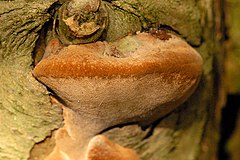Phellinus
| Phellinus | |
|---|---|

| |
| Phellinus pomaceus | |
| Scientific classification | |
| Kingdom: | |
| Division: | |
| Class: | |
| Order: | |
| Family: | |
| Genus: | Phellinus Quél. (1886)
|
| Type species | |
| Phellinus igniarius (L.) Quél. (1886)
| |
| Species | |
|
Species include: | |
Phellinus is a genus of fungi in the family Hymenochaetaceae. Many species cause white rot. Fruit bodies, which are found growing on wood, are resupinate, sessile, and perennial. The flesh is tough and woody or cork-like, and brown in color. Clamp connections are absent, and the skeletal hyphae are yellowish-brown.[1]
The name Phellinus means cork.[2]
The species Phellinus ellipsoideus (previously Fomitiporia ellipsoidea) produced the largest ever fungal fruit body.[3][4]
Phellinus produces the natural phenol hispidin.[5]
Uses
In Australia, Aborigines have used Phellinus fruit bodies medicinally. The smoke from burning fruit bodies was inhaled by those with sore throats. Scrapings from slightly charred fruit bodies were drunk with water to treat coughing, sore throats, "bad chests", fevers and diarrhoea. There is some uncertainty about which species of Phellinus were used.[6]
Species
As of January 2015[update], Index Fungorum lists 154 species of Phellinus:[7]
- Phellinus acifer
- Phellinus acontextus
- Phellinus adamantinus
- Phellinus adhaerens
- Phellinus allardii
- Phellinus anchietanus
- Phellinus andinopatagonicus
- Phellinus andinus
- Phellinus apiahynus
- Phellinus appositus
- Phellinus aureobrunneus
- Phellinus baccharidis
- Phellinus badius
- Phellinus bambusicola
- Phellinus bambusinus
- Phellinus betulinus
- Phellinus bicuspidatus
- Phellinus brevisetus
- Phellinus carteri
- Phellinus caryophylleus
- Phellinus caryophylli
- Phellinus castanopsidis
- Phellinus chocolatus
- Phellinus chryseus
- Phellinus chrysoloma
- Phellinus cinchonensis
- Phellinus coffeatoporus
- Phellinus conchatus
- Phellinus coronadensis
- Phellinus crocatus
- Phellinus crustosus
- Phellinus cyclobalanopsidis
- Phellinus cylindrosporus
- Phellinus daedaliformis
- Phellinus dependens
- Phellinus deuteroprunicola
- Phellinus dingleyae
- Phellinus discipodoides
- Phellinus ellipsoideus
- Phellinus erectus
- Phellinus eugeniae
- Phellinus everhartii
- Phellinus fastuosus
- Phellinus feneus
- Phellinus ferrugineovelutinus
- Phellinus formosanus
- Phellinus fragrans
- Phellinus fushanianus
- Phellinus gabonensis
- Phellinus garuhapensis
- Phellinus gilbertsonii
- Phellinus gilvus
- Phellinus grenadensis
- Phellinus griseoporus
- Phellinus hartigii
- Phellinus himalayensis
- Phellinus hoehnelii
- Phellinus igniarius
- Phellinus incrustaticeps
- Phellinus jezoensis
- Phellinus kamahi
- Phellinus kravtzevii
- Phellinus laevigatus
- Phellinus lapideus
- Phellinus laurencii
- Phellinus leiomitus
- Phellinus linteus
- Phellinus livescens
- Phellinus lopezii
- Phellinus luctuosus
- Phellinus lukinsii
- Phellinus lundellii
- Phellinus luteofulvus
- Phellinus luteus
- Phellinus macroferreus
- Phellinus macrosporus
- Phellinus mangrovicus
- Phellinus melanodermus
- Phellinus membranaceus
- Phellinus merrillii
- Phellinus minimus
- Phellinus minutiporus
- Phellinus mituliformis
- Phellinus montanus
- Phellinus mori
- Phellinus neocallimorphus
- Phellinus neonoxius
- Phellinus neoquercinus
- Phellinus newtoniae
- Phellinus nicaraguensis
- Phellinus nilgheriensis
- Phellinus nothofagi
- Phellinus noxius
- Phellinus ossatus
- Phellinus overholtsii
- Phellinus pachyphloeus
- Phellinus palmicola
- Phellinus piceinus
- Phellinus poeltii
- Phellinus pomaceus
- Phellinus populicola
- Phellinus prunicola
- Phellinus pseudoigniarius
- Phellinus punctatiformis
- Phellinus purpureogilvus
- Phellinus pusillus
- Phellinus quercinus
- Phellinus ralunensis
- Phellinus reichingeri
- Phellinus repandus
- Phellinus resinaceus
- Phellinus rhamni
- Phellinus rhytiphloeus
- Phellinus rickii
- Phellinus rimosus
- Phellinus robiniae
- Phellinus roseocinereus
- Phellinus rufus
- Phellinus sancti-georgii
- Phellinus sanfordii
- Phellinus sarcites
- Phellinus scleropileatus
- Phellinus scorodocarpi
- Phellinus semihispidus
- Phellinus setulosus
- Phellinus shaferi
- Phellinus shoushanus
- Phellinus sonorae
- Phellinus spadiceus
- Phellinus spiculosus
- Phellinus spinescens
- Phellinus subcontiguus
- Phellinus sublaevigatus
- Phellinus sublamaensis
- Phellinus subsanfordii
- Phellinus swieteniae
- Phellinus syringeus
- Phellinus tawhai
- Phellinus tenuiculus
- Phellinus terminaliae
- Phellinus transversus
- Phellinus tremulae
- Phellinus tricolor
- Phellinus tubifragilis
- Phellinus turbinatus
- Phellinus uncinatus
- Phellinus uncisetus
- Phellinus velutinus
- Phellinus viticola
- Phellinus weirianus
- Phellinus weirii
- Phellinus williamsii
- Phellinus zealandicus
References
- ^ Ellis MB, Ellis JB. (1990). "Phellinus". Fungi Without Gills (Hymenomycetes and Gasteromycetes): An Identification Handbook. London, UK: Chapman and Hall. pp. 145–50. ISBN 978-0-412-36970-4.
- ^ Halpern GM (2007). "Phellinus linteus". Healing Mushrooms. p. 95. ISBN 978-0-7570-0196-3.
- ^ Cui B-K, Decock C. (2012). "Phellinus castanopsidis sp. nov. (Hymenochaetaceae) from southern China, with preliminary phylogeny based on rDNA sequences". Mycological Progress. 12 (2): 341–51. doi:10.1007/s11557-012-0839-5.
- ^ Dai Y-C, Cui B-K. (2011). "Fomitiporia ellipsoid has the largest fruiting body among the fungi". Fungal Biology. 115 (9): 813–4. doi:10.1016/j.funbio.2011.06.008. PMID 21872178.
- ^ Lee I-K, Yun B-S. (2007). "Highly oxygenated and unsaturated metabolites providing a diversity of hispidin class antioxidants in the medicinal mushrooms Inonotus and Phellinus". Bioorganic & Medicinal Chemistry. 15 (10): 3309–14. doi:10.1016/j.bmc.2007.03.039. PMID 17387019.
- ^ Kalotas A. (1996). "Aboriginal knowledge and use of fungi". Introduction—Fungi in the Environment. Fungi of Australia. Vol. 1B. Melbourne: CSIRO. pp. 269–95. ISBN 978-0-643-05936-8.
- ^ Kirk PM. "Species Fungorum (version 22nd December 2014). In: Species 2000 & ITIS Catalogue of Life". Retrieved 2015-01-10.
External links
